|
|
|
Sort Order |
|
|
|
Items / Page
|
|
|
|
|
|
|
| Srl | Item |
| 1 |
ID:
084034
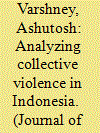

|
|
|
| 2 |
ID:
084035
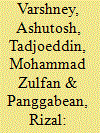

|
|
|
|
|
| Publication |
2008.
|
| Summary/Abstract |
Indonesia has witnessed explosive group violence in recent years, but unlike its plentiful economic statistics, the data on conflict are remarkably sketchy. Because the New Order (1966-1998) wanted to give the appearance of order and stability, it did not believe in publishing reports on group conflict, nor did it allow researchers and nongovernmental organizations to probe the patterns and causes of conflict. This article is based on the first multiyear dataset ever constructed on group violence in Indonesia. Following, and adapting for Indonesian conditions, methodologies developed and used elsewhere, we cover the years 1990-2003, split the data into various categories, and identify the national, regional, and local patterns of collective violence. Much that we find is surprising, given the existing theories and common perceptions about violence in Indonesia. Of the several conclusions we draw, the most important one is that group violence in Indonesia is highly locally concentrated. Fifteen districts and cities (kabupaten and kota), in which a mere 6.5 percent of the country's population lived in 2000, account for as much as 85.5 percent of all deaths in group violence. Large-scale group violence is not as widespread as is normally believed. If we can figure out why so many districts remained reasonably quiet, even as the violent systemic shifts-such as the decline of the New Order-deeply shook fifteen districts causing a large number of deaths, it will advance our understanding of the causes of collective violence in Indonesia.
|
|
|
|
|
|
|
|
|
|
|
|
|
|
|
|
| 3 |
ID:
084036
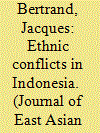

|
|
|
|
|
| Publication |
2008.
|
| Summary/Abstract |
Beginning in the mid-1990s, there was a sudden rise in violent ethnic conflict in Indonesia. Two aspects that require explanation are the timing and clustering of this type of conflict historically. Other studies have not adequately explained these aspects. Methodological and thematic choices have generated problems with identifying and explaining clustering. Microlevel studies fail to account for the broader changes occurring at a macrolevel. Some researchers have chosen to broaden the scope of analysis of violent events to provide explanations of violence more generally. After reviewing these other studies, I argue that a historical institutionalist approach remains best able to explain the clustering of conflicts and the following period of stability. Changing institutional contexts at critical junctures created rising anxieties as well as opportunities to renegotiate group inclusion and status in the Indonesian state.
|
|
|
|
|
|
|
|
|
|
|
|
|
|
|
|
| 4 |
ID:
084039


|
|
|
|
|
| Publication |
2008.
|
| Summary/Abstract |
Recent scholarship on communal violence in Indonesia since the late New Order has focused on identifying causal mechanisms of particular subtypes of communal violence such as large-scale communal violence, town-level communal rioting, intervillage violence, and lynching. While such analyses are useful in understanding aspects specific to each subtype of violence, analyzing each subtype separately risks the analytical problem of selection on the dependent variable if there are important similarities across subtypes. Drawing on the observation that each of these subtypes appeared to rise and fall together since the late New Order, I propose a common factor that can explain the broad temporal patterns of communal violence. In particular, I point to increasing restraints on the military that arose from intraregime infighting, greater scrutiny of military actions during the keterbukaan (political openness) period, and the withdrawal of the military from police duties during Reformasi. I examine four cases of communal conflict: (1) a case in which intravillage violence was averted, (2) a case of lynching, (3) a case of lynching and subsequent intervillage reprisals, and (4) a case of large-scale communal violence. The first three cases are from Lampung province, and the fourth is the case of Poso district, Central Sulawesi.
|
|
|
|
|
|
|
|
|
|
|
|
|
|
|
|
| 5 |
ID:
084040
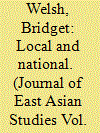

|
|
|
|
|
| Publication |
2008.
|
| Summary/Abstract |
From horrific accounts of men decapitated to "ordinary" accounts of stolen motorcycles, the routine beating and killing of alleged criminals by mobs (massa) has become common in Indonesia. This article examines the patterns of keroyokan-mobbing-from 1995 through 2004 in four provinces and highlights the temporal, spatial, and substantive variations of this phenomenon. Drawing from a database of provincial and local news clippings in Bali, Bengkulu, West Java, and South Kalimantan and in-depth case studies and interviews, this article shows that mobbing varies considerably. Its causes are national and local. The temporal data show that nationally the most important factor to influence levels of mobbing was the introduction of decentralization. The power vacuum that resulted from the policy decision to transfer authority from the center to localities increased local violence. Yet this macrolevel explanation is inadequate to show the spatial variation and different forms of mobbing violence. To understand the causes of these dimensions of variation, one has to move away from macronational approaches measuring violence and include a more microethnographic local approach. A richer understanding of mobbing must be locally rooted. This article uses three case studies to illustrate the centrality of local factors affecting this form of violence. The case studies suggest that mobbing is shaped by the acquiescence of actors in local communities and local learning. The article draws attention to the need to incorporate local data and methods into an analysis of violence in Indonesia and to appreciate varied daily rituals of violence as reservoirs of conflict.
|
|
|
|
|
|
|
|
|
|
|
|
|
|
|
|
| 6 |
ID:
084037
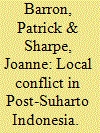

|
|
|
|
|
| Publication |
2008.
|
| Summary/Abstract |
Responding to conflict, in Indonesia and elsewhere, requires an understanding of its distribution, forms, and impacts. In this article, we outline an attempt to use local newspaper monitoring to measure the levels and impacts of violent conflict during the period 2001-2003 in two Indonesian provinces (East Java and NTT). We also assess variation in incidence, impact, and form across and within areas. The study data suggest first that previous research has vastly underestimated the impacts of violent conflict in Indonesia. Comparing our data with those of the previous attempt to use newspapers to map conflict in Indonesia (by the UN Support Facility for Indonesian Recovery [UNSFIR]), we find three times as many deaths from collective violence. These differences are a function of the level of news sources used, with provincial papers picking up only a small proportion of deaths in our research areas. Further, we argue that the impacts of certain types of violence between individuals should be included, leading to even higher figures. Second, our data call into question the dictum that violence in Indonesia is concentrated in a small number of regions. While there is variation between districts, we record large impacts from collective violence in areas not previously considered conflict-prone. Third, substantial variations in conflict form are found across regions, and these result in different kinds of impacts. This underlines the importance of consideration of the role of local factors in driving conflicts and suggests that approaches must be tailored to local conditions. Finally, we demonstrate that using local newspapers to measure and analyze conflicts presents a useful tool for understanding conflict in Indonesia. The use of subprovincial news sources captures more accurate estimates of conflict incidence than other methods, such as provincial newspaper mapping or surveying. It can also provide a basis for a deeper understanding of variations in patterns of conflict across areas and provide insights into how we might respond.
|
|
|
|
|
|
|
|
|
|
|
|
|
|
|
|
|
|
|
|
|